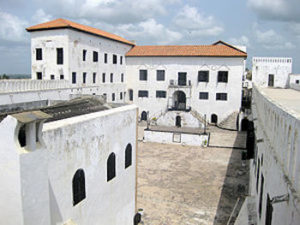
St. George Castle
*The Port city of Elmina in West Africa is recognized on this date in 1441. Elmina was one of many transport locations from the African continent used in the Middle Passage slave trade.
Before the arrival of the Portuguese, the town was called Anomansah in Ghana due to its position on the peninsula and the sea. In 1478, a Castilian armada of 35 caravels and a Portuguese fleet fought a significant naval battle near Elmina to control the Guinea trade (gold, slaves, ivory, and pepper). The war ended with a Portuguese maritime victory and was the first colonial war among European powers. Many more would come. The town was Portugal's West African headquarters for trading and exploiting African wealth. The original Portuguese interest was gold, with 8,000 ounces shipped to Lisbon from 1487 to 1489, 22,500 ounces from 1494 to 1496, and 26,000 ounces by the start of the sixteenth century. The Treaty of Tordesillas in 1494 gave them official commerce priority.
Elmina is also home to Fort Coenraadsburg on St. Jago Hill, built by the Portuguese in 1555 under Forte de Santiago; it was used for commerce. In 1637, it was conquered and remained in Dutch hands after the conquest of Elmina's main castle. Today, Elmina's primary economic industries are fishing, salt production, and tourism. Also, Elmina Castle is very close to Cape Coast Castle. Both castles are notable for their role in the transatlantic slave trade. The Portuguese arrived in 1481, finishing the castle in 3 years. Later, the port expanded to include tens of thousands of slaves channeled through the trading post of Elmina, ten to twelve thousand from 1500 to 35 alone. By 1479, the Portuguese were transporting slaves from as far away as Benin, accounting for 10 percent of the trade in Elmina, and they were used to clear land for tillage.
The location of Elmina made it a significant site for re-provisioning ships headed south towards the Cape of Good Hope on their way to India. After years of Portuguese wealth on the Elmina Coast, the Dutch learned of the profitable activity. The Dutch West India Company captured it in 1637; in subsequent centuries, it was mainly used for the slave trade. It remained in Dutch hands until 1872, when the Dutch Gold Coast was sold to the British. The king of Ashanti, claiming to be the ground landlord, objected to its transfer, and the result was the third Anglo-Ashanti war of 1873–1874.
Also known as Edina, it is a town on the south coast of Ghana in the Central Region, situated on a bay on the Atlantic Ocean, 12 km (7.5 mi) west of Cape Coast. Elmina was the first European settlement in West Africa, with a population of 33,576 people. Beginning in 2003, Elmina, along with foreign investors, began The Elmina Strategy 2015, a massive project to improve many aspects of the town, consisting of water drainage and waste management, helping to improve the health of the citizens, repairing the fishing industry, and harbor of within Elmina, tourism and economic development, improved health services, and enhanced educational services.